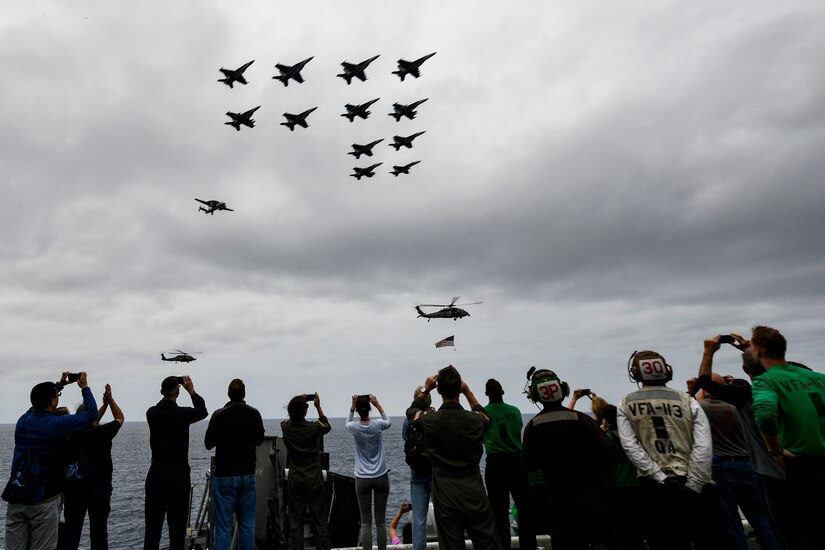By Navy Petty Officer 3rd Class Alex Corona, USS Theodore
Roosevelt
USS THEODORE ROOSEVELT, Pacific Ocean -- Sailors, Marines
and their guests marked the importance of naval aviation here May 3,
remembering more than 107 years of innovation and achievement.
The ship is on its way to its home port at Naval Air Station
North Island, California, after a seven-month deployment. More than 600 family
members and friends embarked aboard the Theodore Roosevelt for a "Tiger
Cruise" during a port call to Pearl Harbor, Hawaii, April 27-May 1.
Navy Capt. Carlos Sardiello, the commander of the USS
Theodore Roosevelt, and Navy Capt. Gus Ford, the commander of Carrier Air Wing
17, spoke of how naval aviation relates to navies, both past and present,
during the celebration hosted by the ship's Naval Heritage Committee in the
hangar bay.
"Aircraft carriers have come a long way,"
Sardiello said. "The USS Pennsylvania started with a wooden deck with
sandbags for arresting gear. Here we are a little over a century later with a
nuclear-powered aircraft carrier."
The captain emphasized the necessity of today's aircraft and
aircraft carriers in operations around the world.
"The importance of the nuclear-powered aircraft carrier
to our nation's defense lies in the fact that it is the only platform that can
deliver air power from the sea in a sustainable fashion," he said.
Family Support
It’s important for the Navy that embarked families and
guests of the sailors and Marines understand life aboard an aircraft carrier,
Ford said.
"It's really hard to understand what it's like to be in
the Navy unless you come out here and experience it for yourself," he
said. "When the family members and friends go home they will talk about
this experience, and what we have accomplished on this deployment will add to
the legacy of the Navy."
"Our Navy and the aviation aspect, together, is an
essential part of our military," Ford said. "We keep the waters open
for trade, have a strong projection of power throughout the world, and protect
the interests of countries throughout the world."
CVW-17 hosted an airpower demonstration for the ship’s
guests, which displayed skills such as low-altitude passes and turns,
high-speed fly-bys, combat maneuvers, and the detonation of live ordnance. The
demonstration ended with 15 aircraft flying in formation over the flight deck.
Sailors, Marines and their guests watched as F/A-18F and
F/A-18E Super Hornets, EA-18G Growlers, F/A-18C Hornets, MH-60S and MH-60R Sea
Hawks and an E-2C Hawkeye performed in the skies above the carrier.
Carrier Air Wing 17
While embarked aboard Theodore Roosevelt, CVW-17 flew 1,164
combat sorties in support of Operation Inherent Resolve and Operation Freedom's
Sentinel. Additionally, CVW-17 flew more than 8,319 hours and operated
approximately 70 aircraft during its 2017-2018 deployment.
The legacy of Navy aviation continues to grow, said Tiger
Cruise attendee Jim Kooyer, a former petty officer who served aboard the
aircraft carrier USS Hancock.
"The same can be said about today's Navy as the Navy
back during the Vietnam War," he said. "An immediate line of defense
and the ability to be any place at any time is critical to accomplish any
mission. This carrier, other naval vessels and the air wing all make that
possible."
Naval aviation has played an integral part in supporting
America's maritime strategy, from the wooden decks of the USS Pennsylvania to
the unforgiving non-skid surface aboard the USS Theodore Roosevelt.
CVW-17 is comprised of Lemoore, California-based Strike
Fighter Squadron 22, Strike Fighter Squadron 94 and Strike Fighter Squadron
113; Beaufort, South Carolina-based Marine Strike Fighter Attack Squadron 312;
Whidbey Island, Washington-based Electronic Attack Squadron 139; Point Mugu,
California-based Carrier Airborne Early Warning Squadron 116; San Diego-based
Fleet Logistics Support Squadron 40, Helicopter Sea Combat Squadron 6; and
Helicopter Maritime Strike Squadron 73.
Theodore Roosevelt left its home port of San Diego, Oct. 6,
2017, for a regularly-scheduled deployment to the U.S. 7th and 5th Fleet areas
of responsibility.









No comments:
Post a Comment